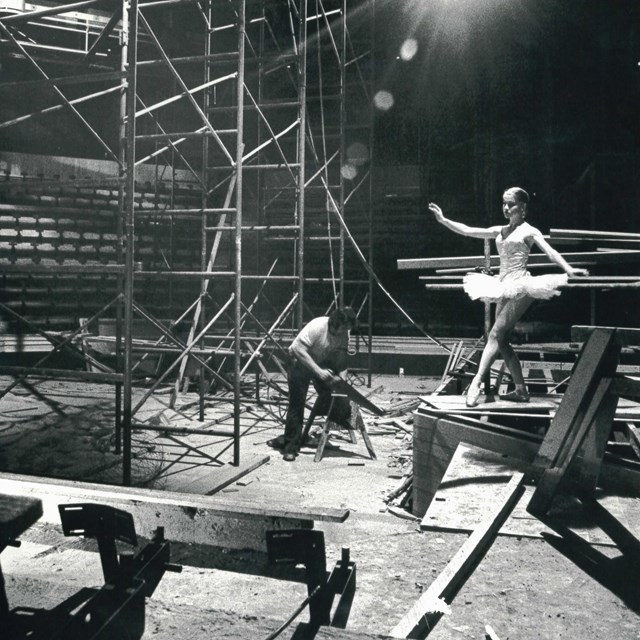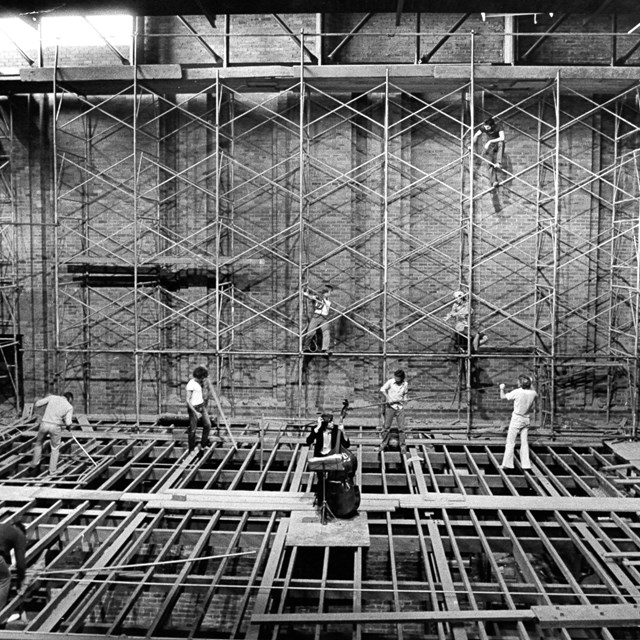Our Brutalist building
Nearly 50 years ago, in spring 1975, Seymour Centre opened its doors for the very first time.
A welcome addition to Sydney's cultural landscape, there were a few things that set the Seymour apart, like its commitment to daring and diverse programming and its status as Australia's first university performing arts centre.
Perhaps the Seymour's most instantly observable feature, though, was its bold, Brutalist design.
The birth of Brutalism
One of the defining architectural styles of the 20th century, Brutalism was born in Europe after the second world war.
Brutalist architects rejected ornate intricacy for a more functional approach, and buildings were constructed using clean lines and simple geometric shapes.
Raw, unpainted materials, particularly concrete, were also showcased as they'd never been before—and in fact, the word 'Brutalism' stems in part from the French term, 'béton brut', or 'raw concrete'.
Arrival on our shores
In the 1960s Brutalism arrived in Australia, where its radical stylings were embraced by a new generation of architects. One such architect was rising star Keith Cottier, a young partner at Sydney-based firm, Allen Jack+Cottier.
Cottier made a name for himself with a series of cutting-edge constructions, and in the early 1970s, his firm was chosen to design the University of Sydney's new performing arts centre, with Cottier as project lead.
Keeping it classical
In keeping with both Cottier's style and the style of surrounding buildings on campus, Seymour Centre was designed in classic Brutalist fashion.
Its exposed steel frame, bare brickwork, defined lines, and unpainted concrete columns are all hallmarks of this iconic architectural style, as are the enormous panels of glass that curtain the front of the building.
A building with buzz
The Seymour's striking design was a point of conversation and praise at the time.
Allen Jack+Cottier won a Royal Australian Institute of Architects award for the building, and a 1975 article in The Bulletin approved of its functional appearance, characterising the Everest Theatre as "an airy brick barn… [with] absolutely no decorative nonsense to distract the attention", and the York as "impressively sombre [and] no-nonsense".
The Reginald, meanwhile, was a "little cell block of a theatre"—an interesting description but really quite apt given its simple, intimate black box design!
A little piece of history
Brutalism fell out of favour in the 1980s, with critics labelling the style as cold and austere.
But while there's certainly a pared-back quality to the Seymour, we'd never think of it as impersonal or unwelcoming—not when we can watch dappled sunlight spill through the panelled windows or observe the crisp curves of the concrete staircase, the precise brickwork of the theatre walls.
The Seymour is a reminder of Sydney's mid-century identity, a building imbued with architectural history. So next time you visit, have a look around and see what Brutalist elements you can pick out. There's magic in the details.
Pictured:
- The Seymour by night, 1982
- The Seymour by day, circa 1975
- The Seymour by day, 2014
- Sydney Festival at the Seymour, 2011
20 September 2021
From outstanding theatre, music and dance to innovative shows for kids, you’ll find something for everyone at the Seymour. Click below to see what’s on.
See what's onNearly 50 years ago, in spring 1975, Seymour Centre opened its doors for the very first time.
A welcome addition to Sydney's cultural landscape, there were a few things that set the Seymour apart, like its commitment to daring and diverse programming and its status as Australia's first university performing arts centre.
Perhaps the Seymour's most instantly observable feature, though, was its bold, Brutalist design.
The birth of Brutalism
One of the defining architectural styles of the 20th century, Brutalism was born in Europe after the second world war.
Brutalist architects rejected ornate intricacy for a more functional approach, and buildings were constructed using clean lines and simple geometric shapes.
Raw, unpainted materials, particularly concrete, were also showcased as they'd never been before—and in fact, the word 'Brutalism' stems in part from the French term, 'béton brut', or 'raw concrete'.
Arrival on our shores
In the 1960s Brutalism arrived in Australia, where its radical stylings were embraced by a new generation of architects. One such architect was rising star Keith Cottier, a young partner at Sydney-based firm, Allen Jack+Cottier.
Cottier made a name for himself with a series of cutting-edge constructions, and in the early 1970s, his firm was chosen to design the University of Sydney's new performing arts centre, with Cottier as project lead.
Keeping it classical
In keeping with both Cottier's style and the style of surrounding buildings on campus, Seymour Centre was designed in classic Brutalist fashion.
Its exposed steel frame, bare brickwork, defined lines, and unpainted concrete columns are all hallmarks of this iconic architectural style, as are the enormous panels of glass that curtain the front of the building.
A building with buzz
The Seymour's striking design was a point of conversation and praise at the time.
Allen Jack+Cottier won a Royal Australian Institute of Architects award for the building, and a 1975 article in The Bulletin approved of its functional appearance, characterising the Everest Theatre as "an airy brick barn… [with] absolutely no decorative nonsense to distract the attention", and the York as "impressively sombre [and] no-nonsense".
The Reginald, meanwhile, was a "little cell block of a theatre"—an interesting description but really quite apt given its simple, intimate black box design!
A little piece of history
Brutalism fell out of favour in the 1980s, with critics labelling the style as cold and austere.
But while there's certainly a pared-back quality to the Seymour, we'd never think of it as impersonal or unwelcoming—not when we can watch dappled sunlight spill through the panelled windows or observe the crisp curves of the concrete staircase, the precise brickwork of the theatre walls.
The Seymour is a reminder of Sydney's mid-century identity, a building imbued with architectural history. So next time you visit, have a look around and see what Brutalist elements you can pick out. There's magic in the details.
Pictured:
- The Seymour by night, 1982
- The Seymour by day, circa 1975
- The Seymour by day, 2014
- Sydney Festival at the Seymour, 2011
20 September 2021
From outstanding theatre, music and dance to innovative shows for kids, you’ll find something for everyone at the Seymour. Click below to see what’s on.
See what's on






